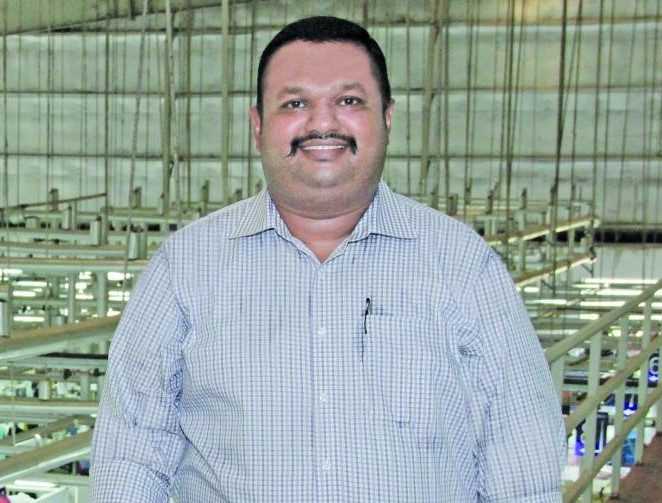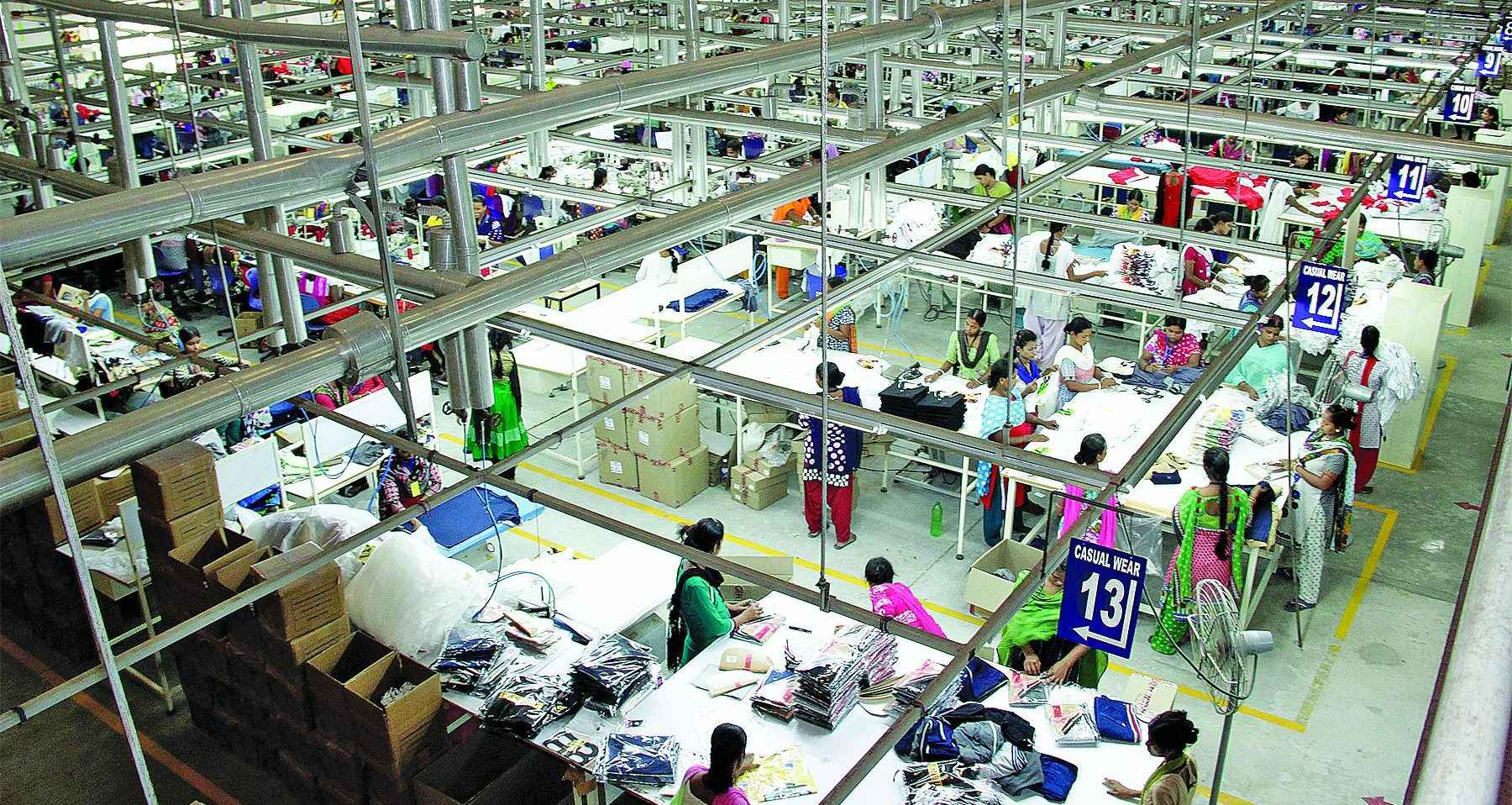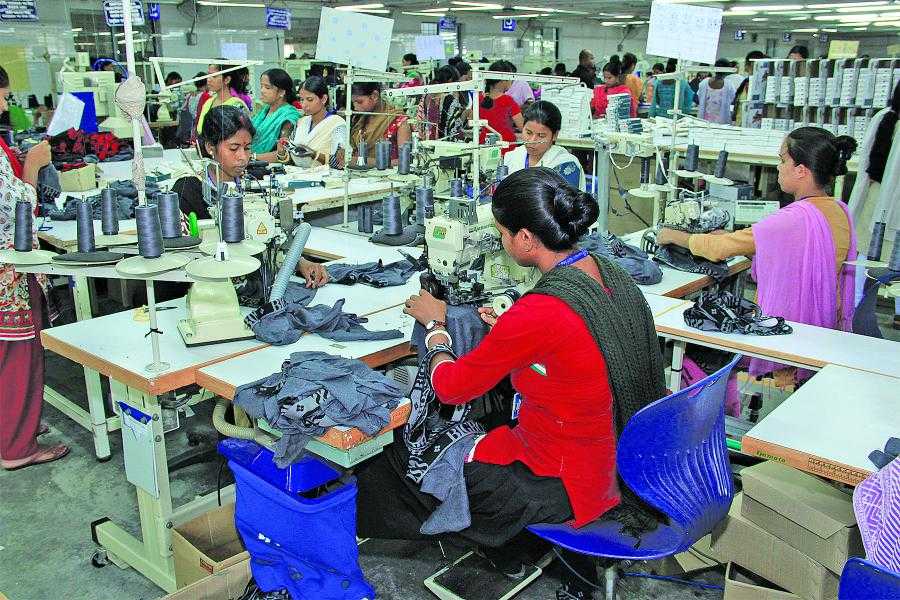
Generally the reason given by most apparel manufacturers for not establishing units in remote regions is lack of skilled labour, even though the unskilled labour here is available in plenty and the wages too are lower compared to the same in major hubs like DelhiNCR, Bangalore and Tirupur, yet they dare not take the plunge. Challenging the odds and following footsteps of India’s largest apparel exporter, who recently established a unit on the Karnataka-Maharashtra border with 700 sewing machines, is Exodus Futura Knits Pvt. Ltd. (EFKPL), a Kolkata-based apparel manufacturer with 400 sewing machines and located just 15 km from Kolkata city. It is not just the willingness of the company to establish a factory in an isolated location, which makes it worth highlighting, but achieving manufacturing excellence within a short period of just 4 years is what matters. Gayan Ruhunage, President – Apparel Manufacturing, Exodus Futura Knits takes StitchWorld around the ‘one-of-a-kind’ facility, which has been working as a modular manufacturing unit from day 1.
Part of the Exodus Group of Companies, Exodus Futura Knit (EFKPL) is owned by Anil Bagaria, Managing Director and Bajarag Lohia, Director. A BSCI-certified facility, EFKPL was established in 2011, with the aim of breaking Kolkata’s dogma of small apparel units housing not more than 30 sewing machines. “The initial plan was for a 100 sewing machines, but I was able to convince Bagaria for establishing a unit with 900 sewing machines; and as of now 400 sewing machines are running,” recalls Gayan, who was headhunted by Anil Bagaria for establishing and managing EFKPL. The company has a legacy of being the first shop floor dyeing unit (industrial unit) established in Eastern India 25 year ago, in Bishnupura, West Bengal. Presently, the fabric unit has 15 knitting machines and dyeing facilities, producing 8 tonnes of fabric per day, 30% of which is consumed by EKFPL, which sources less than 5% of its fabric requirement from other sources.
Manufacturing all kinds of knit products ranging from men’s intimates, women tights, men’s bottoms and polo T-shirts, EFKPL achieved the mark of US $ 5.5 million (Rs. 35 crore) in the last financial year and is positive of achieving US $ 8.6 million (Rs. 55 crore) turnover in this financial year without expanding further.“The current facility is short of being utilized at 100% level right now; otherwise we can reach a turnover of US $ 11 million (Rs. 70 crore) easily from the same setup. Moreover, buyers do not see Kolkata as a sourcing hub and are hence reluctant to working with companies based in the region. Due to the same, our Phase 2 of expansion, wherein we would add another 500 sewing machines, which will double our present turnover to US $ 15.7 million (Rs. 100 crore),” explains Gayan. Presently 60% of the business done by EFKPL comes from the domestic market, but by the 3rd quarter of this financial year, Gayan is confident of generating 60% of the business from the export market. The company is already working with companies such as Decathlon, Bioworld, Lidl, etc. for the export market and with companies such as Reliance, Hegen, etc. for the domestic market.
Isolation – The Reason for Success
Running a factory of 400 machines, employing 600 people and achieving a turnover US $ 5.5 million (Rs. 35 crore) in a time of just 3 years, is a commendable feat for EFKPL, looking at the general manufacturing scenario in Kolkata, a city housing some of the biggest domestic brands such as VIP, Dollar, Rupa, etc. but no brand or company has a unit even one-fourth of the size of EFKPL, making it the biggest apparel unit in Kolkata. The reason for the same is generally the rigid mindset and low trainability of the worker in the region. “Our factory is located in the South 24 Parganas, a region that supplies 80% of the domestic manpower to Kolkata city. Hence unskilled manpower is present in abundance. Even the Sonarpur railway station is just 5 to 10 minutes’ drive away from here. We wanted to empower the unskilled and the unemployed, but promising female population of the region a concept which has done wonders in other apparel manufacturing hub within and outside India,” explains Gayan.

It might sound easy, but it was not the case as a lot of manpower was sent to Gayan for recruitment, from various village leaders and other such influential people. But hiring people blindly was as bad as hiring skilled male operators. “I acted smart and defined the minimum requirements for hiring people. The person should be literate, have basic proficiency in reading and writing and be aged above 18. Further, we specified that they should be a BPL (below poverty line) card holder. We hired women below poverty line to empower them as they had no source of livelihood, even getting the minimum wages means a lot to them, as it can improve their lifestyle significantly,” shares Gayan. Even with such ideas the growth didn’t happen overnight and the management remained patient for the first two years, which is hard to expect from today’s businessmen. “In the first two years, the operators performed satisfactorily as per their standards, but not as per the industrial standards and we could not even push them for better results as they were still learning. By now, all my workers are trained, according to my standards and performing as per the industry standards,” avers Gayan.
Recruitment & Training Programme

Given an opportunity to train people right from the scratch, Gayan made sure that it was utilized to its full potential and instead of teaching people to work in the traditional assembly lines for apparel manufacturing, Gayan introduced to them the much-coveted modular manufacturing system right from day 1, which the company has been successfully following since then. To make the same possible, it was essential to train the operators in a robust manner as the system is dependent on the skill set of the operators, who are required to do more than one operation as a single operation and at times also operate two sewing machines. Skilling of the operators is necessary to be able to reduce the requirement of sewing machines per module, and since the company has an attrition rate of 7% to 8%, continuous training helps the company maintain a steady flow of fresh recruits.
As ‘prevention is better than cure’, the operators are recruited through a comprehensive exam that includes 6 different tests for analysing the reading ability, writing ability, hand-eye coordination, dexterity and general trainability of the operators. The complete tests take a whole day and people who score above 55% are trained as direct operators, and those who have received less than 55% but more than 44% are recruited as indirect operators or helpers. It must be mentioned that of the people who have scored more than 55%, not all will become sewing operators but some of them would be recruited as ironing men, quality checkers, etc. “There is a difference in the salaries according to the skills of an operator, so that an operator cannot question the amount of salary being given to other operators. But everyone receives wages more than the minimum wage rate for unskilled labour, i.e. US $ 100 (Rs. 6,370) per month. Moreover, it is supposed to be like a favour for those operators who had failed the exam by not scoring above 55% and they understand that too from day 1,” adds Gayan.
The operators undergo a 240 hours sewing programme, which is divided into 5 parts – Basic Introduction, Different Types of Stitches, Overlock Sewing Machines, Flatlock Sewing Machines and Special Machine Training. To ensure the success of these training programmes, Gayan has recruited 10 highly skilled and motivated professionals since day 1, which include a GM – Production, Technical Training Head, Quality Manager and Maintenance In-charge, all from Sri Lanka. Besides, Gayan has also recruited other professionally qualified team to lead other departments from various parts of India. These people were also very instrumental in training the middle management of the factory.
Investment in Technology
At the time of its inception in 2011, EFKPL purchased 300 sewing machines, nearly 90% of them from Yamato, the Japanese pioneer in making sewing machines for knits, investing a total of US $ 400,000 (Rs. 2.5 crore) in the same. The company also invested in button attaching and buttonholing equipments from Juki, and single needle lockstitch machines from Highlead. But the investment didn’t end here, as in 2012 EFKPL invested in automatic spreading and cutting equipment from Gerber, and presently the company has two spreaders and one cutter from the American brand. “Having automated machines also restricted the operators from migrating at a high rate because after having worked on these machines, operators find it hard to work on any other basic machine without under-bed trimmers, knee pressure foot lifter, lint collector, etc. and there is no such company nearby having such automated sewing machines,” highlights Gayan.
“Usually people get the fabric and then create a marker accordingly. But in our case, we first generate the marker and cut plan. According to the markers, we decide the knitting diameter and issue the knitting program to our in-house knitting department. Mostly, we work with 30″ to 40″ diameters depending on marker efficiency. The way we cut our fabric has been much applauded by our buyers.” – Gayan Ruhunage
Producing 10,000 pieces per day on an average and undertaking style changeovers every 3rd day, the operations of EFKPL might not seem big enough for satisfying the investment in automatic spreading and cutting, but Gayan disagrees. “It is completely wrong to say that automatic cutting and spreading are viable only in large order quantities. We are successfully using the same and have almost got the return on investment. It again comes down to the same problem of experienced people professing their doctrines,” asserts Gayan. Having made such big investments on automation, EFKPL has not linked the ROI of the same to the minimum FOB of the products they would do. “You can’t ask the buyer to pay for your capital investment. They do not care whether you cut manually or via an automatic machine. Instead one should focus on building efficiencies to get back ROI and a separate plan should be made for getting the ROI of the equipment,” shares Gayan.
Cutting Room Management
The fabric is inspected on the widely popular 4-point system and an inventory of 50 tonnes equivalent to one months’ fabric requirement is kept in stock. “We have developed a Fabric Warehouse Management System to monitor and maintain stocks of fabric. We have given a unique tracking number for each fabric lot, storing information pertaining to type of fabric, quantity etc. about each lot,” explains Gayan. After the cutting, panels are sent to the in-house printing and embroidery divisions for embellishment and 100% checking is conducted of the embellished panels. Of the fabrics used by EFKPL, 25% to 30% have Lycra content ranging from 3% to 5%.
The aspects of pattern making and marker preparation are closely monitored by Gayan himself, who claims that the average marker efficiency is between 80% and 85% and there are minimal fabric wastages, as the company works on both automatic and manual markers.“Usually people get the fabric and then create a marker accordingly. But in our case, we first generate the maker and cut plan. According to the markers, we decide the knitting diameter and issue the knitting program to our in-house knitting department. Mostly, we work with 30″ to 40″ diameters depending on marker efficiency. The way we cut our fabric has been much applauded by our buyers as no one can achieve such consumption rates by following the general practice,” avers Gayan. For intimate wear, single size multi-colour fabric layering system is followed, which ensures that the same size is fed to all the sewing modules. This helps in online packing and maintaining zero WIP in the sewing lines.
Modular Sewing System
Of the 400 sewing machines, 325 machines are allotted to casualwear products, making all kinds of T-shirts, knitted bottoms, basic jackets, etc.; and 75 machines are allotted to intimate wear products such as men’s boxers, briefs, etc. For casualwear, the 325 machines are further divided in 13 lines, each line having modules with number of machines dependent on the SAM of the product; and for intimate wear, 75 sewing machines have been allotted, which are further divided in modules, with each having 7 machines. “If a module has ‘n’ number of sewing machines, a total of ‘n-1’ sewing operators are working in the module as some of the operators are handling two machines and even after combining two operations, as per the manning level, the operators are given an efficiency of 85% for such operations,” adds Gayan, who credits the machines from Yamato for such a feat. The operators are working above an efficiency level of 70%.
The biggest advantage of such a system is the ability to pack products as per the assortment plan given by the buyer, within the modules. Each module has a packing section at the end, which feeds the centralized packing and assortment section on the floor. “The ratio of module-based packing and centralized packing sections is dependent on the assortment plan given by the buyers. For example, to prepare a pack of men’s brief with the product in 5 different colours and in different sizes, each colour would be manufactured by a different module, i.e. a total of 5 modules, which would feed their packed output to the centralized assortment section, which will prepare the final package with the buyers defined assortment for packing,” elaborates Gayan. To minimize the WIP in such a scenario, the sewing modules are fed twice in a day, at 11 am and 4 pm in a working schedule from 9 am to 6 pm. “We evolved this practice because a large amount of pieces cannot be dumped in one go in the line or else the cutting section will start having a lot of backlog. The intimate wear section is the most lucrative for us, not because of the price but because of the fast turnaround times. We produce 10,000 briefs per day,” adds Gayan, who claims that EFKPL is a semi-lean manufacturing company.
The system also has an added advantage in terms of the quality performance, which has enabled the company to achieve almost 100% cut to ship percentage and very minimal quality rejections. In the sewing modules, 1 mid-line, 2 endline and 2 presentation checkers are posted, followed by the auditors for the carton checking. Most of the times, the mid-line checkers are not stationed in the line, as they are roaming QCs, who are taken out of the sewing lines once occurrence of defects has been minimized.
Equally innovative is the system defined by Gayan for production monitoring of sewing lines or modules wherein targets are not given on hourly-basis rather they are given every 15 minutes. “If a person is not able to achieve the target defined in 15 minutes, he/she can cover-up the same in the three successive 15 minutes intervals. Otherwise when a person realizes that he/ she has not met the target, an hour has already passed and there is too much pressure and WIP with the operator to complete the target. This system also has a psychological effect that is quite advantageous. If you ask an operator to give you 200 pieces every hour, they will straight away call it ‘unreasonable’, but if you tell them to make just 50 pieces in 15 minutes, they say it is ‘do-able’,” reasons Gayan. Production recorders are employed to monitor the output of each module/line for every 15 minutes and the same target of 50 pieces per 15 minutes is given to the end-line quality checkers.

Post a Comment